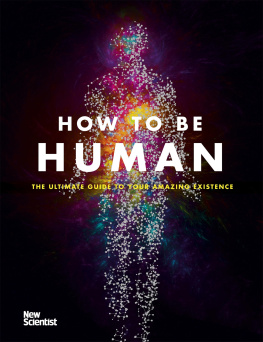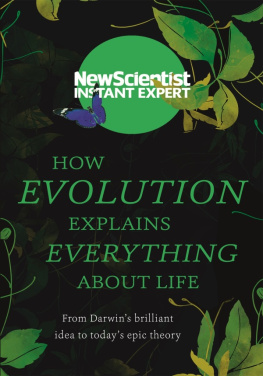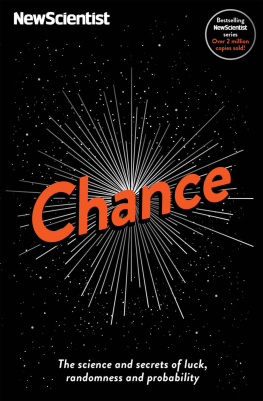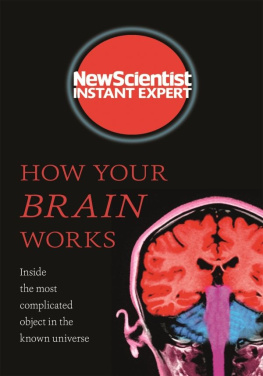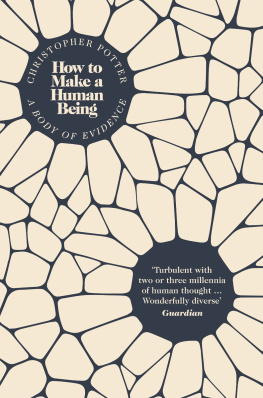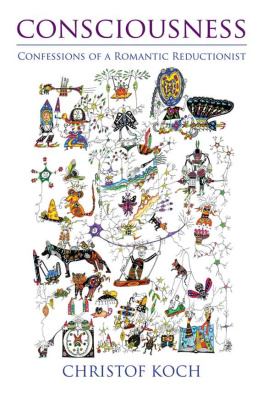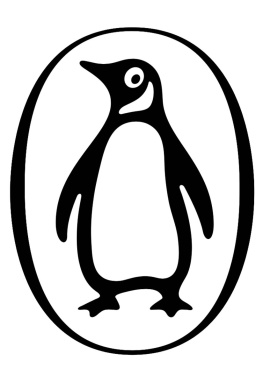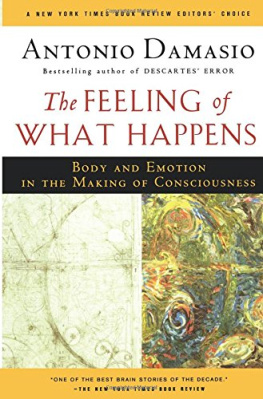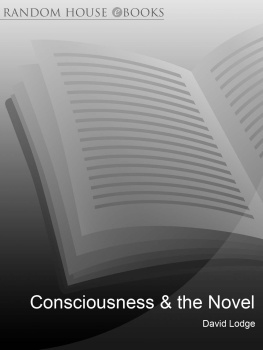Scientist - How to be human: consciousness, language and 48 more things that make you you
Here you can read online Scientist - How to be human: consciousness, language and 48 more things that make you you full text of the book (entire story) in english for free. Download pdf and epub, get meaning, cover and reviews about this ebook. City: London, year: 2017, publisher: Quercus;John Murray, genre: Home and family. Description of the work, (preface) as well as reviews are available. Best literature library LitArk.com created for fans of good reading and offers a wide selection of genres:
Romance novel
Science fiction
Adventure
Detective
Science
History
Home and family
Prose
Art
Politics
Computer
Non-fiction
Religion
Business
Children
Humor
Choose a favorite category and find really read worthwhile books. Enjoy immersion in the world of imagination, feel the emotions of the characters or learn something new for yourself, make an fascinating discovery.
- Book:How to be human: consciousness, language and 48 more things that make you you
- Author:
- Publisher:Quercus;John Murray
- Genre:
- Year:2017
- City:London
- Rating:4 / 5
- Favourites:Add to favourites
- Your mark:
- 80
- 1
- 2
- 3
- 4
- 5
How to be human: consciousness, language and 48 more things that make you you: summary, description and annotation
We offer to read an annotation, description, summary or preface (depends on what the author of the book "How to be human: consciousness, language and 48 more things that make you you" wrote himself). If you haven't found the necessary information about the book — write in the comments, we will try to find it.
Scientist: author's other books
Who wrote How to be human: consciousness, language and 48 more things that make you you? Find out the surname, the name of the author of the book and a list of all author's works by series.
How to be human: consciousness, language and 48 more things that make you you — read online for free the complete book (whole text) full work
Below is the text of the book, divided by pages. System saving the place of the last page read, allows you to conveniently read the book "How to be human: consciousness, language and 48 more things that make you you" online for free, without having to search again every time where you left off. Put a bookmark, and you can go to the page where you finished reading at any time.
Font size:
Interval:
Bookmark:

Illustrations by Jennifer Daniel
First published in Great Britain in 2017 by John Murray (Publishers)
An Hachette UK company
First published in USA in 2017 by Nicholas Brealey Publishing
Copyright New Scientist 2017
Illustrations Jennifer Daniel 2017
The right of New Scientist to be identified as the Author of the Work has been asserted by them in accordance with the Copyright, Designs and Patents Act 1988.
All rights reserved. No part of this publication may be reproduced, stored in a retrieval system, or transmitted, in any form or by any means without the prior written permission of the publisher, nor be otherwise circulated in any form of binding or cover other than that in which it is published and without a similar condition being imposed on the subsequent purchaser.
A CIP catalogue record for this title is available from the British Library
UK ISBN 978-1-473-62927-1
USA ISBN 978-1-473-65871-4
Picture Editor: Kirstin Kidd
Additional writing by Kate Douglas, Caroline Williams and Catherine Brahic
Copy editor: Ned Pennant-Rea
Proof readers: Steve Cox and Chris Simms
John Murray (Publishers)
Carmelite House
50 Victoria Embankment
London EC4Y 0DZ
www.johnmurray.co.uk
Nicholas Brealey Publishing
Hachette Book Group
Market Place Center, 53 State Street
Boston MA 02109, USA
www.nicholasbrealey.com
Contents
Take a look at yourself
A few years ago more than either of us would probably care to admit we both attended a New Scientist event on the nature of animal minds. In one memorable talk, an eminent biologist described how sheep get nervous if they are left alone they evolved to live in flocks, after all. His remedy? Put a mirror in the pen. It fools them into thinking they have company.
Sheep are not much blessed with self-awareness. Like most other species on Earth, they cannot recognise themselves in a mirror. But, as a member of the planets smartest species, you are different. You know its you gazing back out of the glass.
This rare ability is shared by only a handful of brainy species. In humans its a milestone of infant development, showing that a child is acquiring a sense of self. In turn, this helps to kick into action memory and important social skills, such as reading the intentions of others.
Your own memory, sense of self and mind-reading abilities have been crucial in shaping who you are. And you is what this book is all about how you got to be who you are and what makes you tick. Well also look more widely at us: what sets humans apart from other animals and how we can be so similar yet individually unique.
The nature of humans has intrigued scholars for many thousands of years. The ancient Greek philosopher Socrates is said to have started the ball rolling, though it was his successors Plato and especially Aristotle who had the most influence on subsequent thought. But Aristotle, as usual, got plenty of things wrong: he believed that the heart was the seat of thought and reason and the brain was for cooling the blood, for example. That view held for nearly 2,000 years until William Harvey discovered that the heart is simply a mechanical pump.
As with many discoveries in science, that brought our view of ourselves down a peg or two. We once considered ourselves to be a special (though fallen) creation of God, made in His image and living at the centre of a cosmos made for us; nowadays, were more likely to understand ourselves as an accidental product of evolution living in an uncaring cosmos with only our deeply flawed brains to guide us.
But at least we have retained our sense of humour. As the American essayist Christopher Morley once said, a human being is basically an ingenious assembly of portable plumbing. Theres more to us than that, of course, and the discoveries of science have uncovered a creature way more fascinating than any theological ideal. Who would have thought, for example, that laughter has less to do with humour than it has social control?
So what is a typical human like?
Theres no doubt were smart. Our big brains are the main reason we live such different lives from the rest of Earths inhabitants; they have enabled us to go from savannah-dwelling huntergatherers to the creators of a civilisation with aspirations to cure death, colonise other planets and build machines that are even smarter than us.
Weve been on a 7-million-year evolutionary journey from when we last shared an ancestor with chimpanzees. Darwins big idea has proved crucial to understanding ourselves, from why each of us has a different personality, where our morals come from, to why only some of us can digest milk.
Being upright, and not walking on all fours, enabled our hands to become strong, dexterous, multifunctional tools perfect for turning thoughts into things, such as stone axes, music, skyscrapers and text messages. It also allowed us to evolve into supreme endurance predators, able to run quarry to exhaustion. Without this bounty of high-quality protein it is unlikely that our ancestors would have evolved their big brains.
One trait we tend to overlook is our predilection for possessions, yet it is a defining characteristic of our species. Early humans would probably not have migrated from Africa without warm clothing, tools for hunting, gathering and preparing food and the means to make fire. No other animal depends on so much stuff to survive. It is also via possessions that we express many other facets of our character including status, symbolism and aesthetics.
Were also incorrigibly talkative. We are the only creatures with complex language, which has enabled us to create knowledge, add to it and pass it on to others. Language also facilitates our intensively social nature: to be talkative we need somebody to talk to. We thrive in the presence of friends and family and wither without them. But language also helps to divide us into mutually unintelligible and often hostile tribes.
If this description sets the scene for this book, the drama itself focuses on the human condition, the experience of being alive and the events and stages we face in our journey through life. Youll find here what science tells us about generosity, belief, disgust, why we pick up bad habits and find it hard to kick them. Well also cover lifes phases from birth to death, how children change their parents and the upsides of old age.
Understanding humans and their place in the cosmos is fundamental to what we do at New Scientist. The text of How to Be Human owes so much to the insatiable curiosity and expert knowledge of our brilliant colleagues, and to the dozen guest authors, who write here on topics such as the nature of friendship and why we get hooked on religions. When it comes to illustrations, Jennifer Daniel has provided highly entertaining infographics covering everything from the curious concept of personal space to the link between Stephen Hawking and Black Sabbath; while Kirstin Kidd has found fascinating photographs revealing what it means to be human that range from 30,000-year-old art right up to the latest technology for freezing people who want a second chance at life. We only hope you enjoy reading this book as much as weve enjoyed writing it.
This is undoubtedly a great time to be writing about humans. Science is generating so many insights on so many fronts. Take for example, the sequencing of the human genome which is not only revolutionising medicine and human biology but its also revealing home truths about our ancestors, who clearly enjoyed sexual liaisons with Neanderthals.
Font size:
Interval:
Bookmark:
Similar books «How to be human: consciousness, language and 48 more things that make you you»
Look at similar books to How to be human: consciousness, language and 48 more things that make you you. We have selected literature similar in name and meaning in the hope of providing readers with more options to find new, interesting, not yet read works.
Discussion, reviews of the book How to be human: consciousness, language and 48 more things that make you you and just readers' own opinions. Leave your comments, write what you think about the work, its meaning or the main characters. Specify what exactly you liked and what you didn't like, and why you think so.

